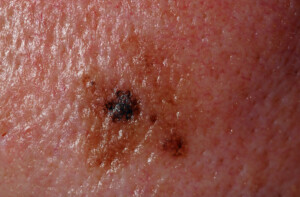
Can a melanoma that spreads to the brain ever cause tinnitus?
The brain is one of the first places that a melanoma tumor metastasizes to.
This can result in a variety of symptoms.
Tinnitus is the so-called ringing in the ears that affects many people and that has a multitude of causes.
“When melanoma spreads, it has certain places that it prefers to spread to,” says Dr. Steven Musick, MD, a board certified dermatologist who runs Musick Dermatology, LLC, in Swansea, IL, which provides state-of-the-art medical and surgical care for all disorders of the skin, hair and nails.
“Those places are the skin near where the melanoma was removed, lymph nodes, lungs, liver and brain.
“When melanoma spreads to the brain, it can cause a wide array of symptoms depending on what parts of the brain that the melanoma lodges and grows in.
“Certainly it could cause tinnitus (ringing in the ears), but melanoma would not be a common cause of this symptom.”
In fact, if you develop tinnitus, it is enormously far more likely to be caused by aging, very recent exposure to loud noise, hearing loss, earwax buildup, stiffening of the inner ear bones, TMJ disorder, abnormal inner ear fluid pressure, head congestion, loose hair in the inner ear canal, sinus infection, head or neck trauma, thyroid disease, diuretics and antibiotics, hardening of the arteries and high blood pressure.
If melanoma were to ever cause tinnitus, the mechanism would be the tumor pressing on blood vessels in the head.
The sound in this case would be pulsing in nature, most likely in synch with your heartbeat.
It would not be the continuous high frequency tone of hissing, fizzing or buzzing that’s so characteristic of more common (and benign) causes of tinnitus.
10 Risk Factors for Melanoma

Early melanoma. Cancer.gov
Excessive Sun Exposure: Prolonged exposure to ultraviolet (UV) rays from the sun increases melanoma risk. Sunburns, especially in childhood, heighten this risk.
Tanning Beds: Use of tanning beds, which emit UV radiation, significantly raises the likelihood of developing melanoma.
Fair Skin: Individuals with lighter skin that burns easily and tans poorly are at higher risk for melanoma compared to those with darker skin.
Family History: A family history of melanoma or other skin cancers can increase an individual’s risk, suggesting a genetic predisposition.
Multiple Moles: Having a large number of moles or unusual moles (dysplastic nevi) can elevate melanoma risk.
Personal History: Those who have had melanoma or other skin cancers previously are at greater risk for recurrence.
Weakened Immune System: Individuals with compromised immune systems, whether due to medical conditions or immunosuppressive treatments, are more susceptible to melanoma.
Genetic Mutations: Specific genetic mutations, such as those in the CDKN2A gene, are linked to higher melanoma risk.
Age: Although melanoma can occur at any age, the risk increases with age, with older adults being more susceptible.
Geographic Location: Living in regions with high UV exposure, such as near the equator or at high altitudes, raises melanoma risk.

Steven Musick, MD









































